PONTAL DO PARANAPANEMA
BIOME:
ATLANTIC FOREST
REGION:
SOUTHEAST OF THE STATE OF SÃO PAULO
1.910
BENEFICIARIES
CHALLENGE:
TO DEVELOP SYSTEMS AND METHODOLOGIES FOR LANDSCAPE MANAGEMENT, FINDING A BALANCE OF SOCIO-ECONOMIC GAINS BY MAINTAINING SERVICES FOR THE ECOSYSTEM AND WORKING TO CONSERVE SPECIES AT RISK OF EXTINCTION.
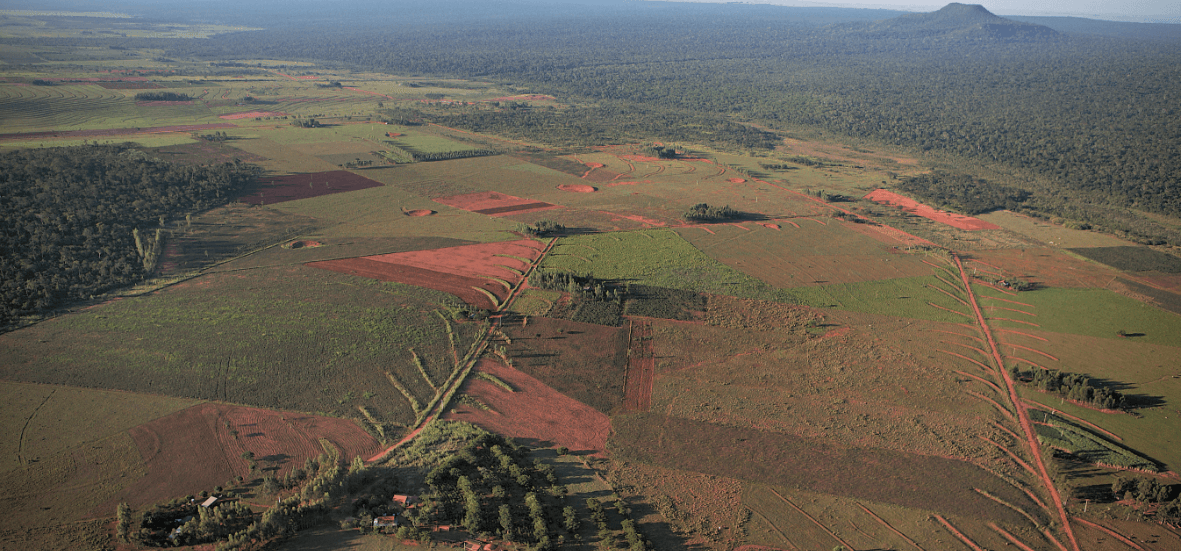 picture by: Arquivo IPÊ
picture by: Arquivo IPÊ
The west of São Paulo state contains parts of the river basins of Pontal do Paranapanema, Rio do Peixe and Rio Aguapeí. It is also home to the interior of the Atlantic Forest. This area is known as Seasonal Semi-deciduous Forest (SSFs) and is the most endangered part of the Atlantic Forest.
The small areas of forest which still exist there are each separated. As a result, these forests which are home to important flora and fauna, become vulnerable to forest-fires among other things. These effects stop animals from being able to move around the forests therefore reducing their chances of feeding and reproducing, which can lead to extinction.
With this challenge in mind, IPÊ researchers, the Forest Foundation, the Department of Infrastructure and Environment of the state of São Paulo (SIMA), and from other civil society organizations have developed an operational plan for connecting Conservation Units and Protected Areas in the west of São Paulo.
As a result of fieldwork and four major meetings in 2019, the group established a complete database of the region's biodiversity and was able to map areas of western São Paulo state which would be ideal for forest connections and conservation. The information pointed out key work that needed for reconnecting the forests such as creating new conservation units and establishing some new and more economical wildlife corridors. The aim is to do this with the support and participation of rural landowners as well as involving local communities.
One of IPÊ's key goals is to create and monitor community involvement projects, environmental education and social and economic initiatives that allow forest restoration work to have workable results for both the people and the planet.

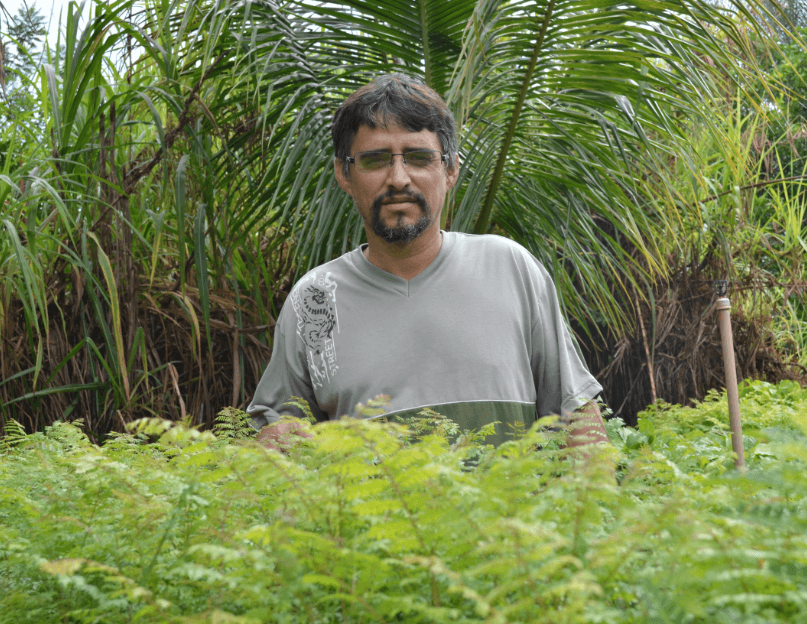 picture by: Arquivo IPÊ
picture by: Arquivo IPÊ
We support sapling growers such as Aderson Renivaldo
Borges Gomes (photo) who is a resident of São Bento
in Teodoro Sampaio (São Paulo). His nursery produces 60 thousand
saplings per year, with 25 different species
The saplings are sold to companies who need
to meet reforestation quotas.
The restoration can be quite profitable for the Western Region of São Paulo. Research data from the Brazilian biodiversity and Ecosystem Services Platform (BPBES) and International Institute for sustainability (IIS) suggests that 200 jobs are created for every 1,000 hectares that are restored. This doesn't take into account the positive impact of other productive activities such as planting vegetables all of which is key to agroforestry. And it is estimated that up to 77 thousand hectares could be restored in this region.
In August, IPÊ promoted a workshop on this topic at Morro do Diabo State Park, in Teodoro Sampaio (São Paulo). Producers, organisations and business men and women came together to evaluate the regional market for forest restoration and how this could boost the local economy. The workshop helped start "The Market Study of Forest Restoration and Wildlife Corridors between western São Paulo's Conservation Units"
We promote restoration of forestry in the wildlife corridors connecting the conservation units of Pontal do Paranapanema. In the one known as the North Corridor we delivered environmental education and agroecology training to 300 farmers and students. We also helped increase income for the communities involved by producing and commercialising native tree saplings from their forest-based nurseries. These are social enterprises with the goal of socio-economic and environmental development for the farming families living on land reform settlements.
Over the course of more than 20 years, along with the development of the wildlife corridors, IPÊ has promoted training for eight community forest nurseries located in different settlements throughout the region which the institute is closely following. Most take the form of associated or cooperative groups, but there are still private initiatives managed by farmers who have participated in our free training programmes. In 2019, the nurseries produced approximately 800,000 saplings helping support 40 people in the region.
The Atlantic wildlife corridors initiative relies partner institutions for the work they do, these include: Natura, BNDES, Petrobras, Funbio, Whitley Fund for Nature, Durrell Wildlife Conservation Fund, CTG, CESP, Morro do Diabo State Park, Teodoro Sampaio City Hall, State Public Prosecutor's Office, Saving Species Fund, among others. ECOSIA collaborated with the initiative in 2019 and restored 200 hectares. Another of IPÊ's partners is WeForest.
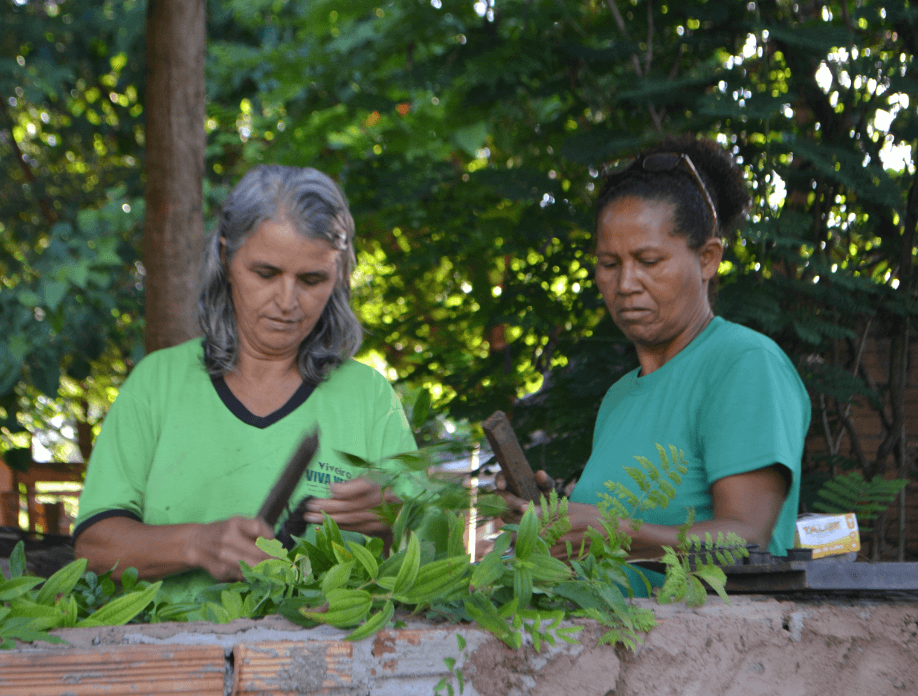
picture by: Laurie Hedges
In Pontal do Paranapanema, IPÊ restores wildlife corridors that connect Conservation Units within the Atlantic Forest. Check out the results from the North Corridor project:

Agroforestry Systems (AFS) sustainably enhance agricultural production, balancing economic, social and environmental gains. In Pontal do Paranapanema, IPÊ helps support 51 families in rural settlements with this system. This, in an area that can have a considerable impact on the protection of the Atlantic Forest. In 2019, IPÊ offered technical rural assistance to producers who have implemented and continue to manage agroforestry and agroecological systems. It is farmers who relied on the proposal to implement the SAFs in 2015 and 2016 - combining the planting of native tree species with fruit trees and coffee, which began to bear fruit this year.
The monitoring of the impact of AFSs carried out by the Department of Infrastructure and Environment in the state of São Paulo. This is done through the agroforestry panel, which collects biophysical data from IPÊ concerning agroforestry in Pontal and other locations. The information is available in the AFS spreadsheet for São Paulo, developed under the Sustainable Rural Development Project (PDRS). The tool is for free public use, to assist in financial planning and economic evaluation of agroforestry systems (AFS).
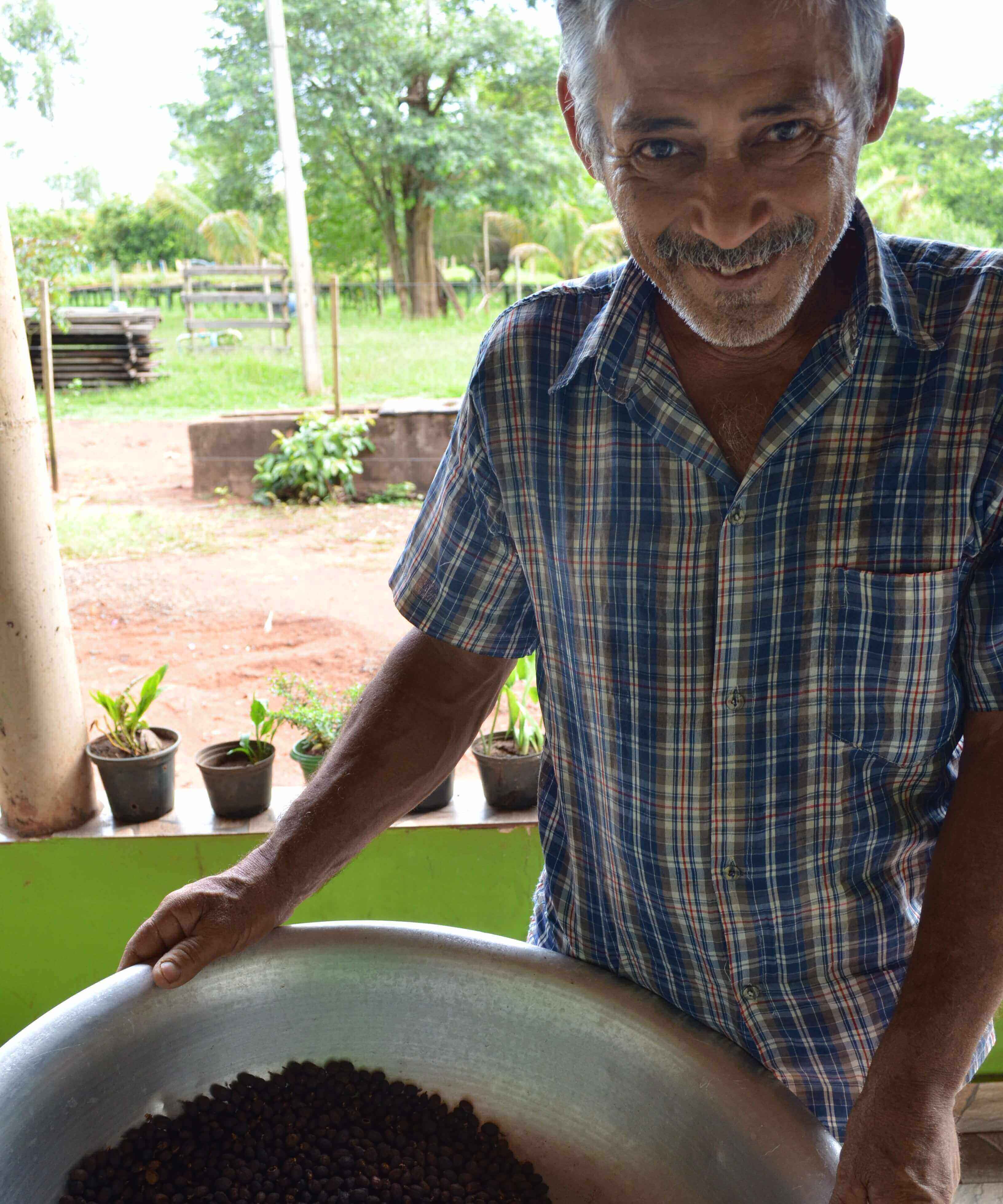
picture by: Arquivo IPÊ
Coffee can be one product of implementing agroforestry systems (AFS). Overall, 51 rurally settled families plant coffee trees within the Atlantic Forest. This creates a higher level of biodiversity in the area and also stops the weather from greatly affecting the coffee harvest. The growers can generally earn more from this product and the support provided by IPÊ also helps. In 2019, 560 kg of coffee was harvested and 920 packets of roasted and ground coffee was marketed in places such as the Chão Institute, in São Paulo.
Biodiversity: legacy for the future
IPÊ's initiatives in Pontal do Paranapanema promote sustainability within the local population, with restoration projects and initiatives to increase local income. these projects guarantee the conservation and restoration of the habitat for several species of regional fauna and flora. The Institute also surveys and manages species. The work carried out with one of these species, the black lion tamarin, began before IPÊ was
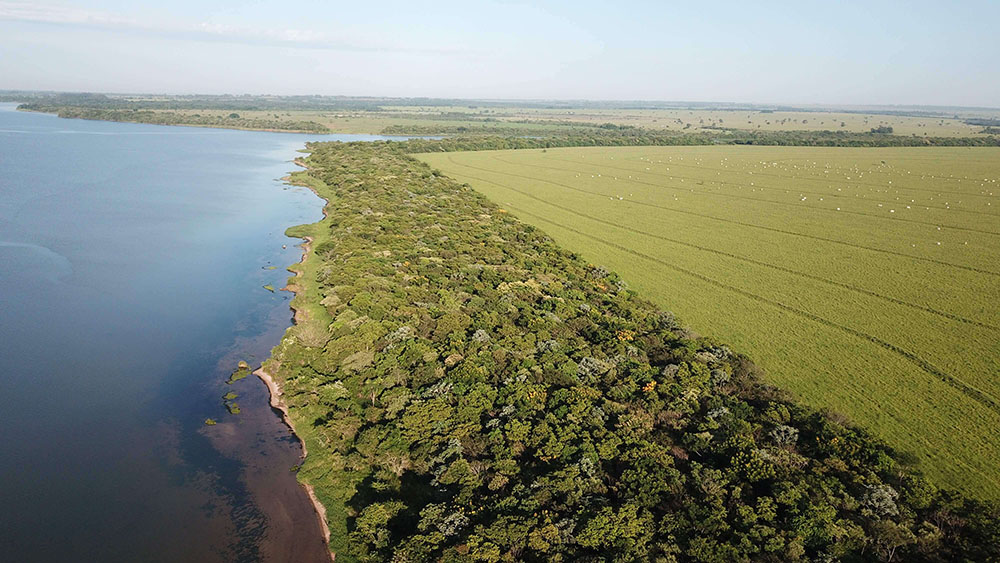
picture by: Laurie Hedges
The so-called "Dream map" for the most ideal reconnecting of the forestry in Pontal do Paranapanema is one of IPÊ's initiatives. It outlines the best sites in both Legal Reserve Areas and Permanent Preservation Areas for forest replanting, so that the new trees can directly benefit the recovery of the biodiversity. Today this model is used for other connectivity initiatives in particular areas.
This map guided the design of Atlantic Forest wildlife corridors implemented by IPÊ in Pontal. The largest of them, covering 1,200 hectares with 2.4 million trees, connects the Morro do Diabo State Park (PEMD) and the Ecological Station Black Lion Tamarin (ESEC-MLP), increasing the chances of survival of endangered species and helping stop which has become the most serious environmental problem in the region.
- Black Lion Tamarin (Leontopithecus chrysopygus)
- Spotted Jaguar ((Panthera onca)
- Tapir (Tapirus terrestris)
- Brazilian Guinea Pig (Cavia cf. aperea)
- Altantic Forest Climbing Mouse (Oecomys cleberi), known only in the Pontal do Paranapanema,
- pale-headed blindsnake (Liotyphlops cf. beui)
- Broad-snouted Caiman (Caiman latirostris)
- Cuvier's dwarf Caiman (Paleosuchus palpebrosus) - at risk in São Paulo and with
unprecedented numbers for the Pontal do Paranapanema.
The largest wildlife corridor ever restored in Brazil is in the Atlantic Forest, in Pontal do Paranapanema (São Paulo) and was planted by IPÊ (Institute of Ecological Research). This corridor consists of 2.4 million trees occupying 1,200 hectares of land and is within the Rosanela Farm Permanent Preservation Area.
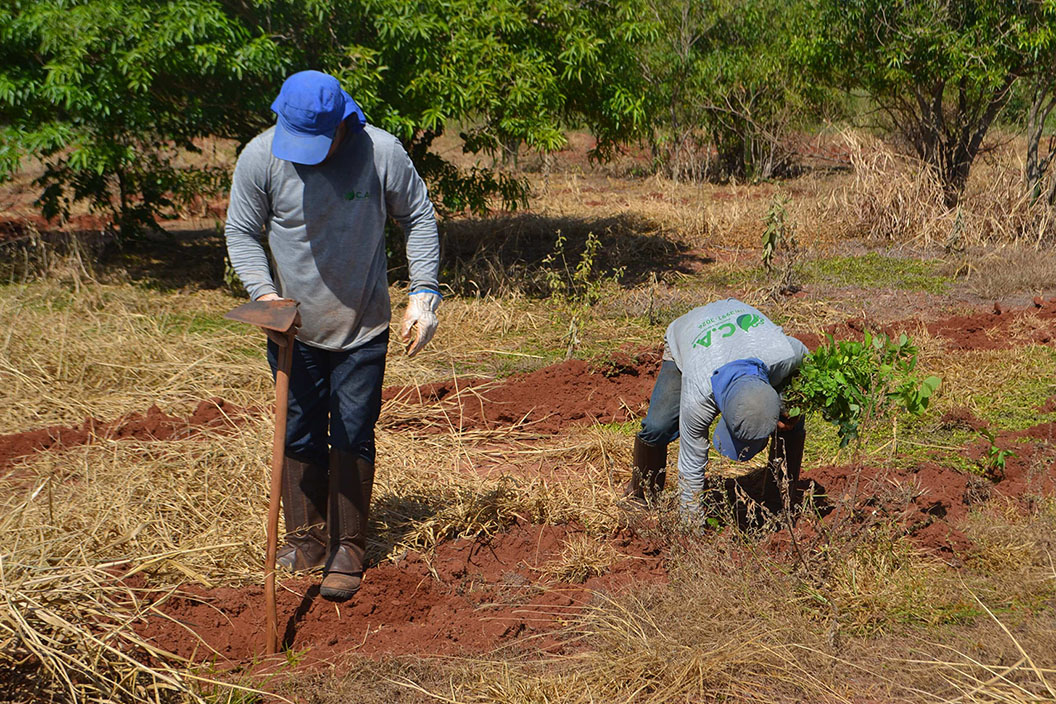
picture by: Laurie Hedges
In 2019, IPÊ took a new and important step in the development of the wildlife corridors of the Atlantic Forest project with the commencement of planting for the "Northern Wildlife Corridor", located north of Morro do Diabo State Park (PEMD). The goal is for the Northern Corridor to be reforested - a total 1 million trees covering 500 hectares of land. The area chosen for the wildlife corridor belongs to the Alcidia Distillery, a priority site for forest restoration. The project was designed by Atvos as environmental compensation, through the Nascentes do Estado program in São Paulo, the city's Department of Infrastructure and Environment (SIMA) which has been delivering fines in the form of required environmental work.
300 producers with training in biodiversity conservation
120 rural producers in the production of saplings in agroforestry nurseries
40 producers in the provisioning of planting and forest maintenance services
20 professionals: coordinators, educators, extension workers and researchers
70 more hectares of restored forest area
150,000 more trees
3 further kilometres of forests, which add to the first wildlife corridor of the Atlantic Forest which was completed by IPÊ in 2011.
Together, the two wildlife corridors now reach a total of 2,850,000 trees.

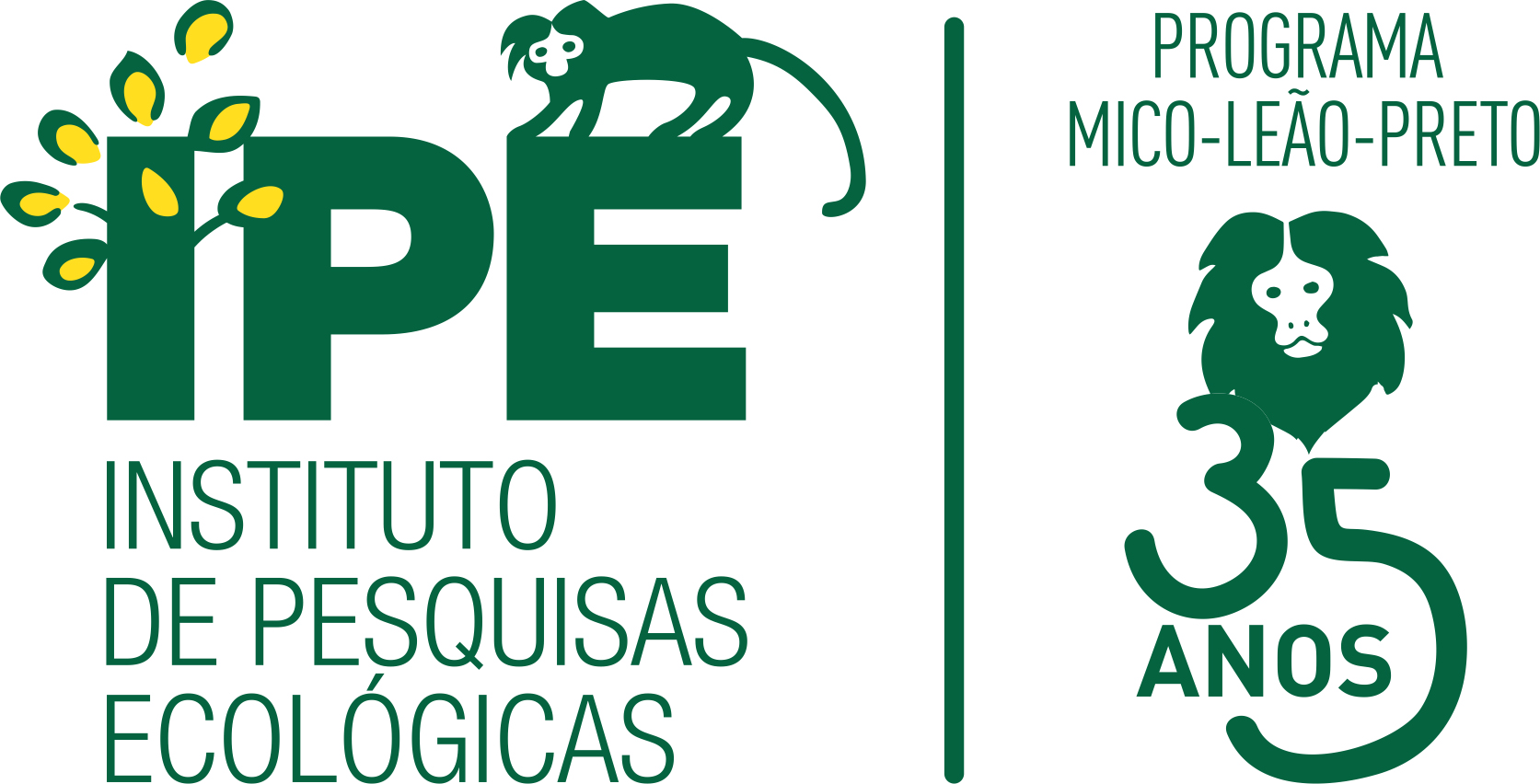
One of the longest-running species conservation initiatives in Brazil is The Black Lion tamarin Conservation Program. This program, created by IPÊ in the São Paulo Atlantic Forest region, celebrated, in 2019, 35 years of research and work in aid of this species (Leontopithecus chrysopygyus). From this project, the Institute formed the groundwork in developing a whole methodology of innovative biodiversity conservation, based on: scientific research, environmental education, community involvement in sustainable business, restoration of vegetation in the landscape and support for public policies.
Learn more about this story ipe.org.br/ipe
Lear more about the Black Lion Tamarin in our timeline:
ipe.org.br/en/linhadotempo-mlp

In order for the wildlife corridor to offer all necessary resources to the tamarins, we started artificial tree hollowing in the hopes they'll return to the restored areas. We did so because new trees are not yet hollow at all and tamarins usually use the crevices as shelter during the night. The man-made hollows are monitored by cameras, to identify when tamarins and other arboreal animals use them.
The project is supported by the Disney Conservation Fund, the Sustainable Lush Fund, and developed in partnership with the Laboratory of Primatology (LaP) of UNESP Rio Claro (São Paulo).


Another major supporter of the Black Lion Tamarin Conservation Program is the Durrell Wildlife Conservation Trust. In 2019, the Black Lion Tamarin campaign was joined by the Jersey institution (United Kingdom) to carry out strategic planning and developing unique annual campaigns to support IPÊ's work in protecting this species. All the money raised will be invested in: management of wild populations (translocation), habitat management (restoration and implantation of artificial tree hollows), managing the population in captivity and team training.

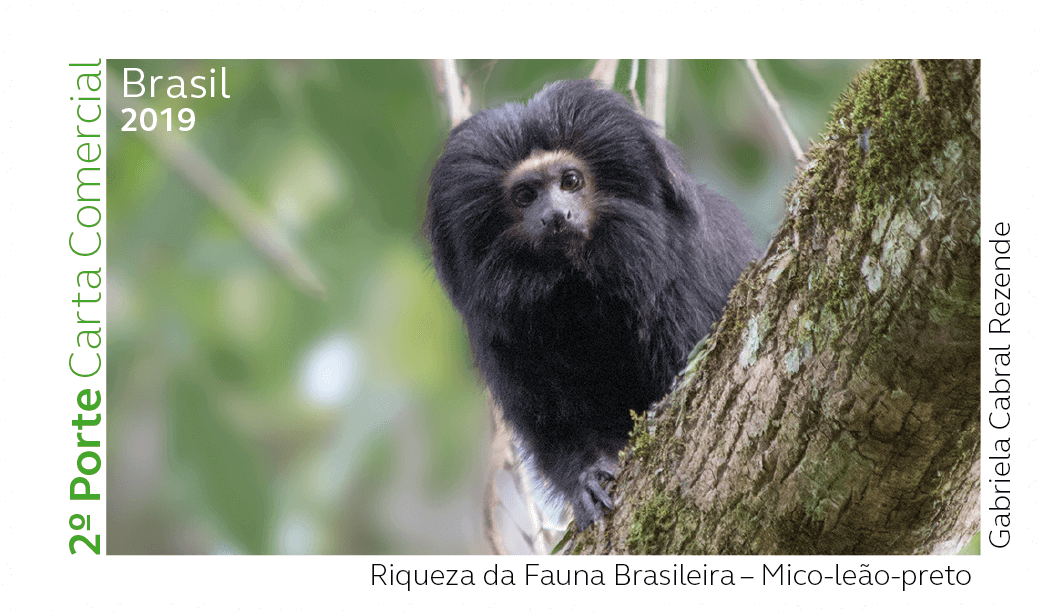
• The tamarin on postage stamps - A symbolic species for the state of São Paulo, the black lion tamarin was included as part of a special run of postage stamps in 2019. They were joined by other species - Beetle Larvae (sometimes known as glow-worms - Pyrearinnus termitilluminans), which cause the phenomenon known as the Luminous Termite Tree, and the sloth (Bradypus torquatus). The photograph featured on the stamps was taken by the biologist Gabriela Cabral Rezende, a researcher at IPÊ. Turn an animal into a postal stamp and it's popularity soars.
• The Primate Congress, with education and the Black Lion Tamarin on the agenda - the 18th Brazilian Congress of Primatology (6th to 10th of November), run by the Brazilian Society of Primatology (SBPr), brought education to the debate, with the theme "educating primates". The opening of the event in Teresópolis (RJ) was held by the president of IPÊ, Suzana Padua. Suzana, PhD of environmental education, argues that the subject should be treated as a science, as are other activities involving the conservation of primates in Brazil.
• Trends in Primate Research - Congress sought to advance two key issues in primate research and conservation in Brazil: the use of species-monitoring technology in the field and communication technology for conservation. Opening up discussions on education and communication in reference to primate conservation was also new.
They are 153 species and subspecies, 23% of which are critically endangered, especially those primates living in the Atlantic Forest and in the arc of deforestation area (Amazon Rainforest). IPÊ, for 35 years, has strived to conserve the black lion tamarin which is a symbol of the state of São Paulo.
ENVIRONMENTAL EDUCATION: THE PONTAL'S LEGACY
In 2019, the Pontal Bom para Todos (Healthy Pontal Region for Everyone) program continued to develop planned projects within the black lion tamarin conservation program. In all, it involved 1,600 people, including students, teachers and heads of Public Schools in eight municipalities of Pontal do Paranapanema, in addition to promoting community engagement activities.
The environmental education promoted by IPÊ is a long-term project which has been of great value for the city of Teodoro Sampaio. It is part of the school curriculum in the municipality, due to the work done by the institute in the region which has been taking place since before its official founding in 1992.

For 21 consecutive years teachers from the Pontal do Paranapanema region have relied on IPÊ for environmental education skills development. Through courses, lectures and workshops that are all free of charge, we've already trained 3,700 teachers, which, apart from just training said teachers, also means higher-level training for students and locals.
The partnership with public sector teachers is worthwhile for the schools and the community. Such is the case for the Salvador Moreno Munhoz State School, in Teodoro Sampaio, whose teachers have been partnered with IPÊ since 2003, when they started the Sinal Verde (green sign) project. Said project is responsible for the installation of a native saplings nursery and is one of the school's strongest ties with both IPÊ and environmental issues.


Just as the nursery is an important environmental education tool in the school of Teodoro Sampaio, LABECA - Laboratory of Biology and Education, Environmental Conservation has the same role in the State School Professroa Maria Audenir de Carvalho, in the municipality of Primavera. Close to 200 evening class students participated in the laboratory as an optional class. The initiative began in 2019 to debate the issue of Amazon fires and climate change, with the idea that it would become a space for discussion and conservation of biodiversity work.
“We talk about fires, climate change and political issues like disciplines of science, biology and chemistry. It's a space where we discuss environmental issues which don't often have time to be debated in the classroom - it compliments the students' mandatory classes”, , explains Maria das Graças, IPÊ coordinator of Environmental Education.
In 2020, the goal of LABECA's project is to provide students with a scientific induction through Brazil's Citizen Science school program, exploring permanent preservation areas and legal reserves within the municipality's urban area so that the community has eyes on, and gets to know the value of nature in their green areas.

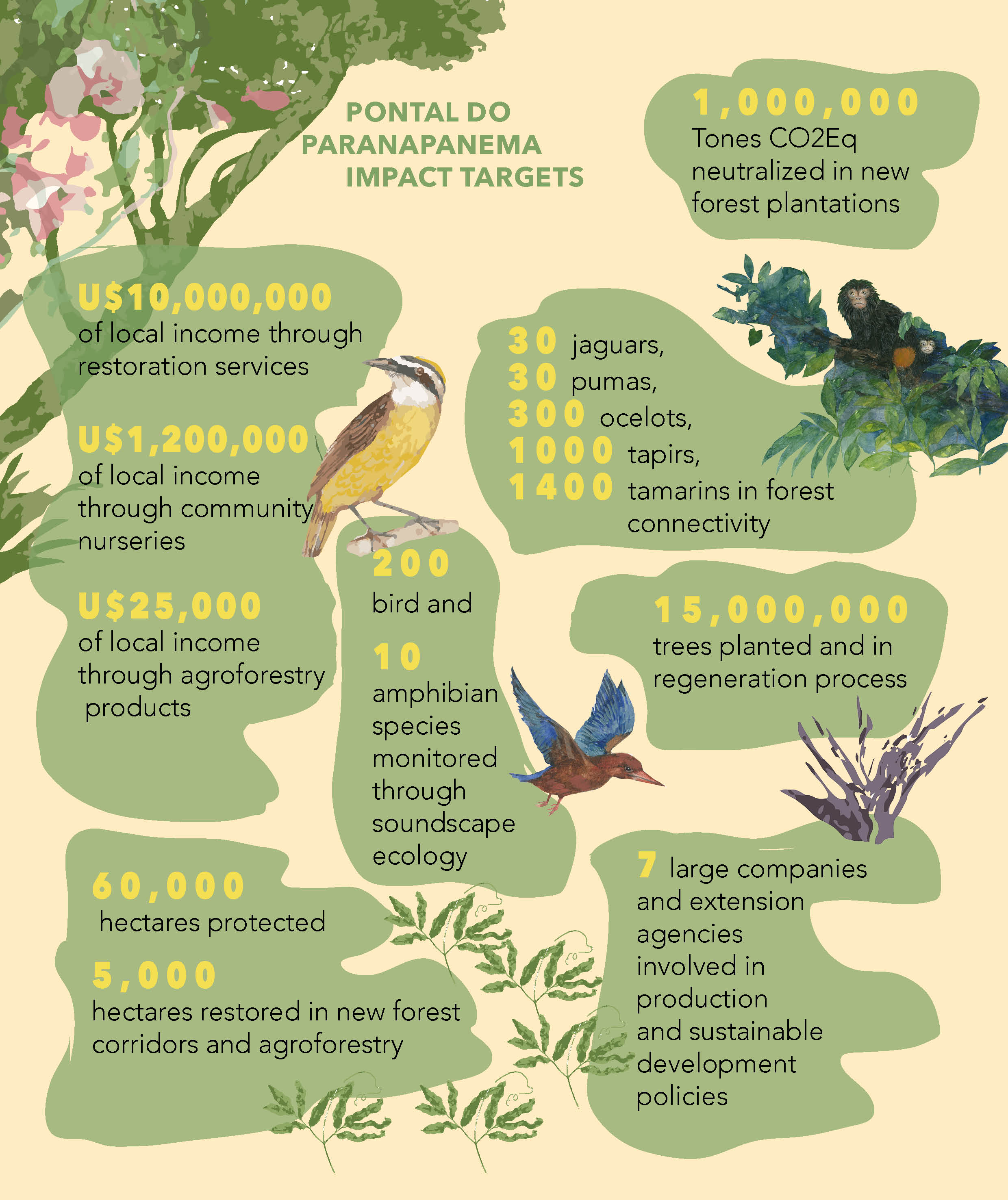
NAZARÉ PAULISTA AND CANTAREIRA SYSTEM
BIOME:
ATLANTIC FOREST
REGION:
SOUTHEAST OF THE STATE OF SÃO PAULO
AND SOUTHEAST OF MINAS GERAIS
BENEFICIARIES:
2,024
CHALLENGE:
TO CONSERVE ECOSYSTEM SERVICES WITH THE APPLICATION OF SCIENTIFIC RESEARCH AND COMMUNITY INVOLVEMENT. WORK PROPOSES BETTER LAND USE WITH NEW PRODUCTIVE SYSTEMS AND ENVIRONMENTAL EDUCATION, FAVORING WATER RESOURCES AND THE REMAINING FOREST IN THE REGION.
The city of Nazaré Paulista (São Paulo) is home to the IPÊ headquarters. The region is of strategic importance for the conservation of the Atlantic Forest and the maintenance of important ecosystem services, such as water resources. Since 2013, the Institute has expanded its work to encompass cities comprising the Cantareira Supply System, which provides water to about 7.6 million people in the metropolitan region of São Paulo and another 5 million in Campinas and Piracicaba. In addition, they supply surrounding rural producers and companies that collect water from the rivers that feed into the system. Despite its large size, the Cantareira System is not particularly resilient, which can lead to periodical water shortages. IPÊ´s data indicate that there is a deficit of 35 million trees in Permanent Preservation Areas (PPAs) that extend the length of the system.
The Semeando Água project, sponsored by the Petrobras Socio-environmental Program, is seeking to overcome this challenge. In cities that have a direct impact on water production for the Cantareira System (Bragança Paulista, Joanópolis, Mairiporã, Nazaré Paulista, Piracaia, in São Paulo; and Extrema, Camanducaia and Itapeva, in Minas Gerais), we introduced environmental education, courses and practices to improve land use, social engagement and restoration programmes. The recognition guaranteed the project's nomination for the 7th "Action for Water Award", promoted by the PCJ Consortium (Piracicaba, Capivari and Jundiaí), in 2019.
People reached by Environmental Education and Rural Extension: 2,350
People reached by social networks and indirect work: 29,390
Trees planted: 34,000 saplings across 20 hectares.
Number of properties with operations: 13

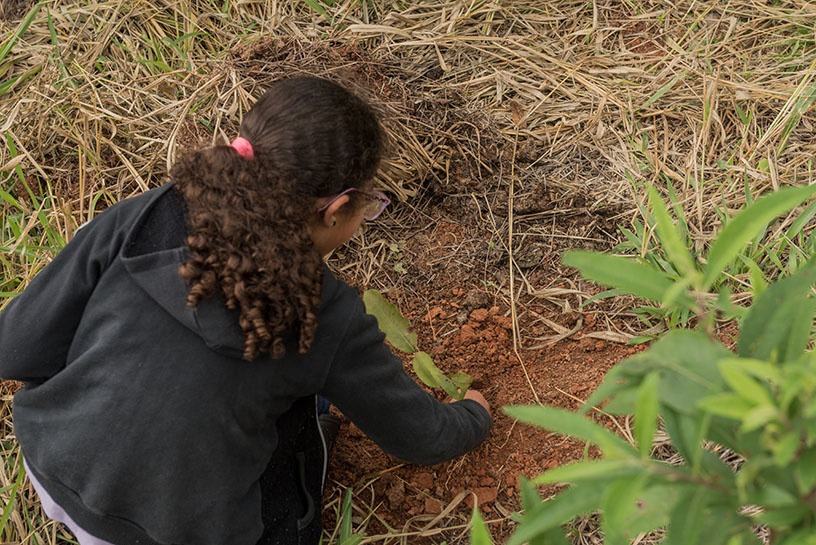 picture by: Arquivo IPÊ
picture by: Arquivo IPÊ
In the Cantareira System, we brought environmental education to 2,350 people in 2019, including 500 public school teachers in municipalities we operate in. Teachers are fundamental to fostering a culture of higher socio-environmental awareness To that end, we offer tools to provide practical help in the teaching of socio-biodiversity issues.

 picture by: Ilana Bar/Estúdio Garagem
picture by: Ilana Bar/Estúdio Garagem
With projects such as Semeando Água, we seek not only to reforest but also to encourage better soil practices that make a difference to the safety of the water. Social participation in the restorative planting carried out by IPÊ is promoted to help cultivate a relationship between people and nature. In 2019, more than 60 employees from companies located in the Cantareira System region and the Paulínia Refinery (Replan/Petrobras) participated in communal planting work. In addition, they had the chance to see how Agroforestry Systems and syntropic agriculture are carried out in Nazaré Paulista (São Paulo).

In 2019 we published three more video classes to reach even more people with quality informative content: Rural producers and those interested in Forest Restoration, Agroforestry Systems and Native Forestry. bit.ly/restauracao_florestal e bit.ly/SAFs_silvicultura.
Para educadores, reunimos uma série de dicas capazes de reforçar o aprendizado da sala de aula, por meio de vivências. Acesse: bit.ly/Semeando-Agua-educacao-ambiental.

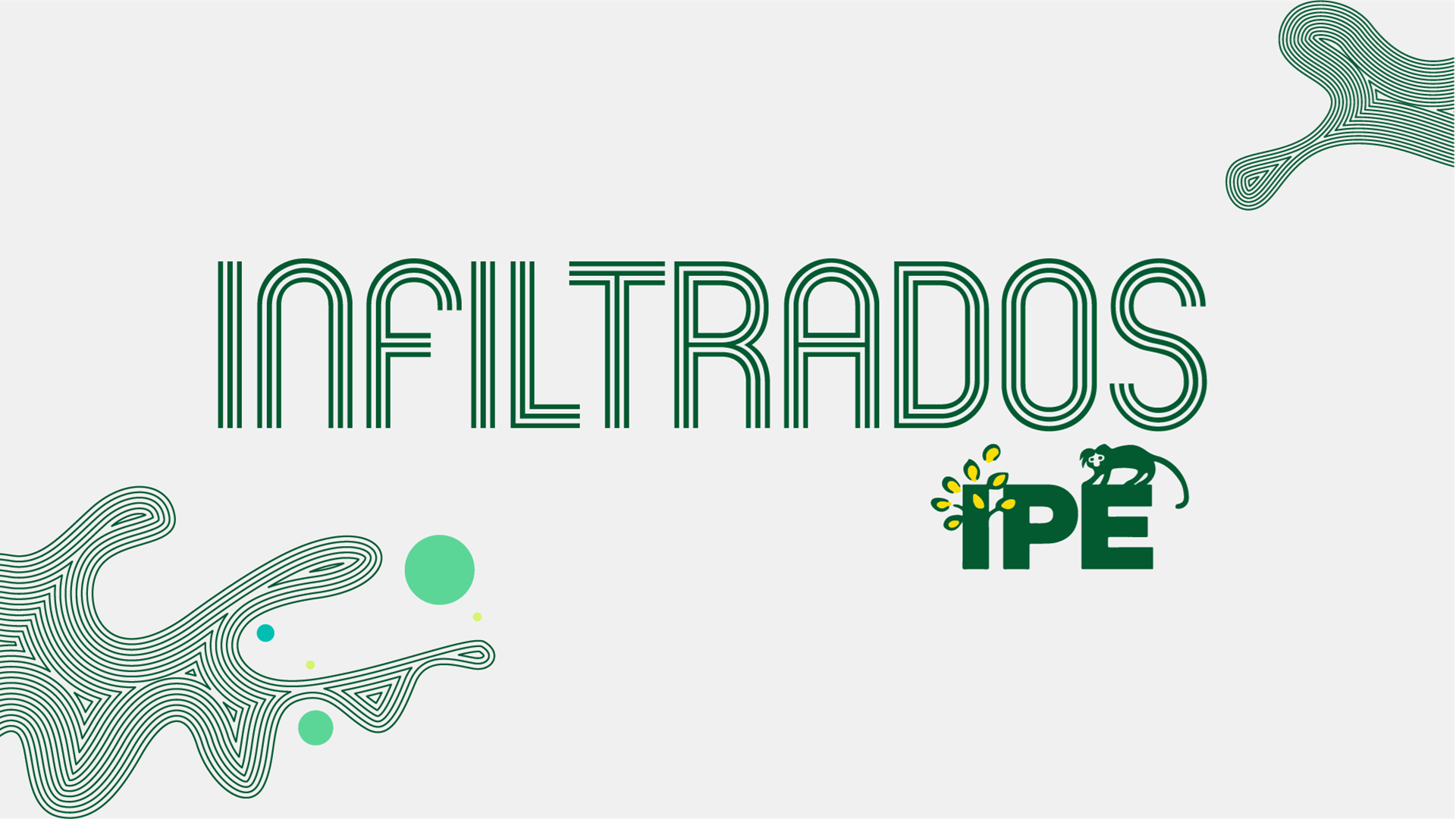
A network of IPÊ insiders was put together by the Semeando Água project with a mission: to spread information on WhatsApp groups about The Caminho da Água (Way of Water), A Produção do Cantareira(The Cantareira Production), The Impact of Scarcity (O Impacto da Escassez) and How to Sow Water (Como Semear Água).
That's why the IPÊ insiders campaign, developed by the Talquimy communication agency, identified more than 800 micro-influencers of various profiles. The target audience was the population supplied by the Cantareira System, especially that of the metropolitan region of São Paulo.
The movement reached more than 390,000 people, who had access to materials, animations, videos, articles and also participated in a Facebook live-stream, which brought accurate, quality information to these everyday conversation channels.
The campaign became a case:
talquimy.com.br/cases/infiltrados-ipe/

Like in all IPÊ projects, the subject of public policies in Semeando Água enables important developments, such as the development of partnerships to create regional strategies and alternatives. That's why we participate in events related to Water Resources Management and others that complement biodiversity conservation.
With the importance of institutional relationships in mind, in 2019 we promoted the Fórum Desafios e Oportunidades para Segurança Hídrica(Challenges and Opportunities for Water Safety) in the Cantareira System and established a Technical Cooperation Agreement with the Forest Foundation of the State of São Paulo, organizing the 1st Scientific-Technical Symposium of the Cantareira Continuum (I Simpósio Técnico-Científico do Contínuo Cantareira).

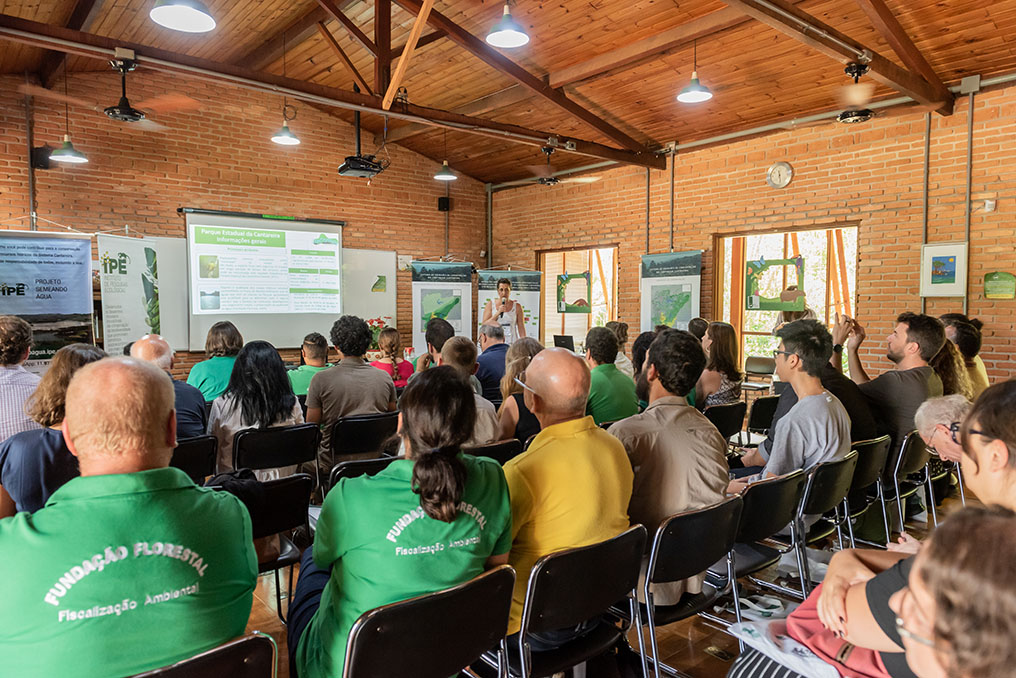 picture by: Ilana Bar/Estúdio Garagem
picture by: Ilana Bar/Estúdio Garagem
The Cantareira Continuum Protected Area System, or continuum Cantareira, is a complex formed by several conservation units, which are essential for the formation of a connecting corridor between the forest fragments of the Serra da Cantareira mountain range and the forest ranges of the Serra da Mantiqueira. They are the Cantareira state parks, Itaberaba, Itapetinga, Pedra Grande Natural Monument, Guarulhos State Forest, the APA Cantareira System and the Usina District Dam.
Because of their significance, they are now research development areas which provide crucial results to the development of conservation and management strategies for the Protected Areas and their surroundings.
As to learn about work undertaken in the region, identify gaps in knowledge and seek strategies for the promotion of applied research, IPÊ gathered at the 1st Scientific-Technical Symposium of the Cantareira Continuum (I Simpósio Técnico-Científico do Contínuo Cantareira), on October 30 and 31, in Nazaré Paulista (São Paulo). The event had Fundação Florestal (Forest Foundation,) together with ESCAS - Faculty for Environmental Conservation and Sustainability, the Semeando Água project and the Forest Institute as partners.
As a result, an action plan for local research was developed, alongside a Good Practice protocol between Protected Areas managers, researchers and universities and a document with the priority areas of research.


Productivity improvements in the field as well as soil and water conservation, an increase in biodiversity, are all the results seen by rural landowners upon implementing IPÊ's methods. In an event that celebrated the results of the Semeando Água project, producers who adopted the methods commented on the experience.
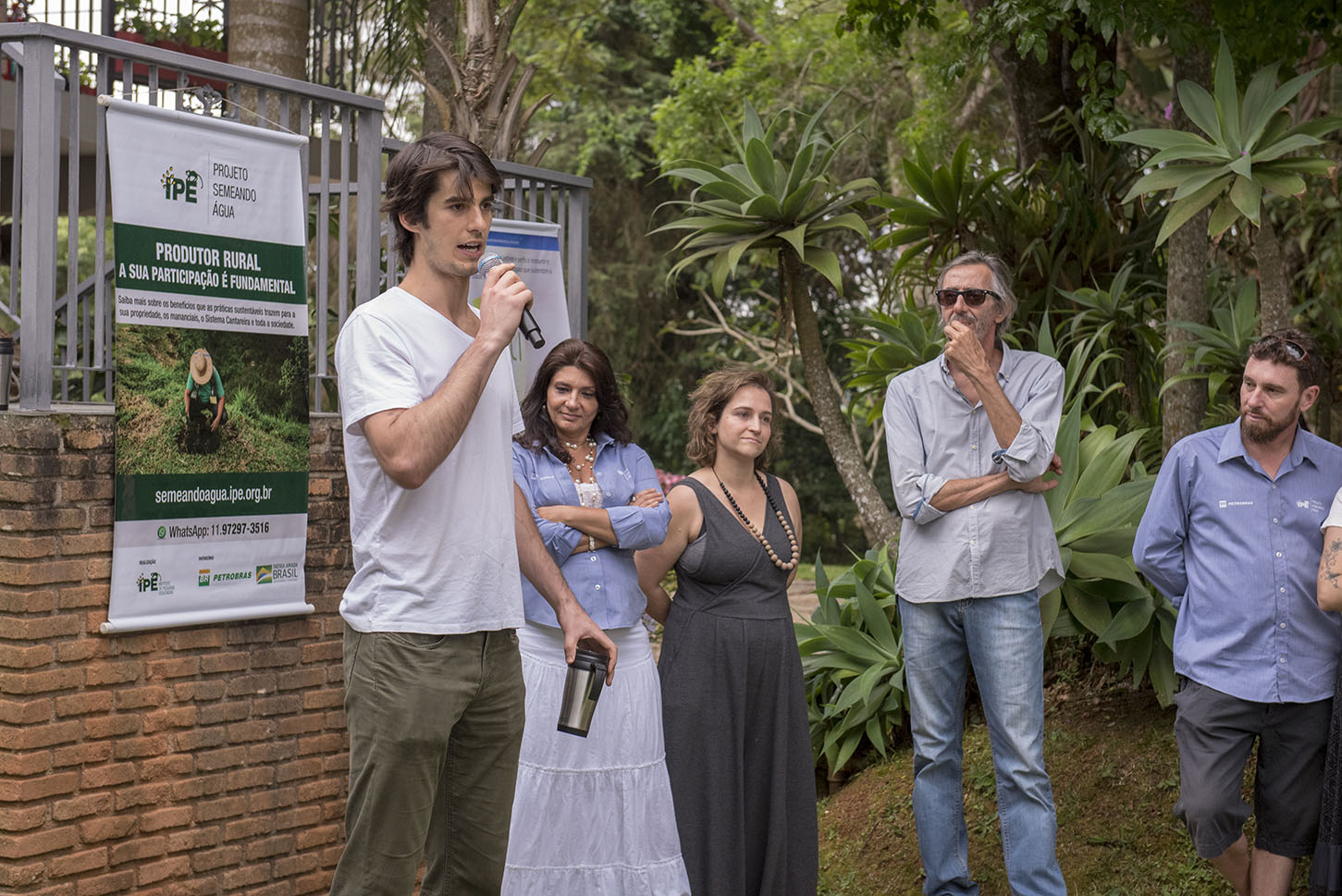 picture by: Tiago Baccarin/ Estúdio Garagem
picture by: Tiago Baccarin/ Estúdio Garagem
"I had the chance to get to know IPÊ through a producer, I did the first module of the ecological pastures course that is heavily linked to sustainability, through the triple bottom line; social, environmental and financial. We also did forest restoration around the bodies of water in the PPAs, it was really encouraging to see the progress that was made. I'm really happy with this partnership and I'm rooting for the extension so it helps more and more people" Ricardo Troster,, rural property-owner from Joanópolis.
Lázaro Brandão, manager of the Social Responsibility sector at Petrobras attended the event. "It's with great pleasure that we support initiatives such as the Semeando Água project, lead by IPÊ, and to see this network of all the partners, institutions, [and] local producers. This is where we make a difference, in taking local action, in the training and development for families, schools, the managers - all in a network, advancing together. The results are concrete, tangible".
PANTANAL AND CERRADO
Biome:
Pantanal and Cerrado
Region:
Mato Grosso do Sul
7,232
BENEFICIARIES
The Challenge:
To develop solutions for the conservation of the lowland tapir (Tapirus terrestris), the giant armadillo (Priodontes maximus) and the giant anteater (Myrmecophaga tridactyla). To that end, we're carrying out projects on scientific research, population modeling, development of conservation strategies, environmental education, training and empowerment, scientific tourism and communication. Since 2019, IPÊ has been advancing socio-environmental research in the western region of the Pantanal.
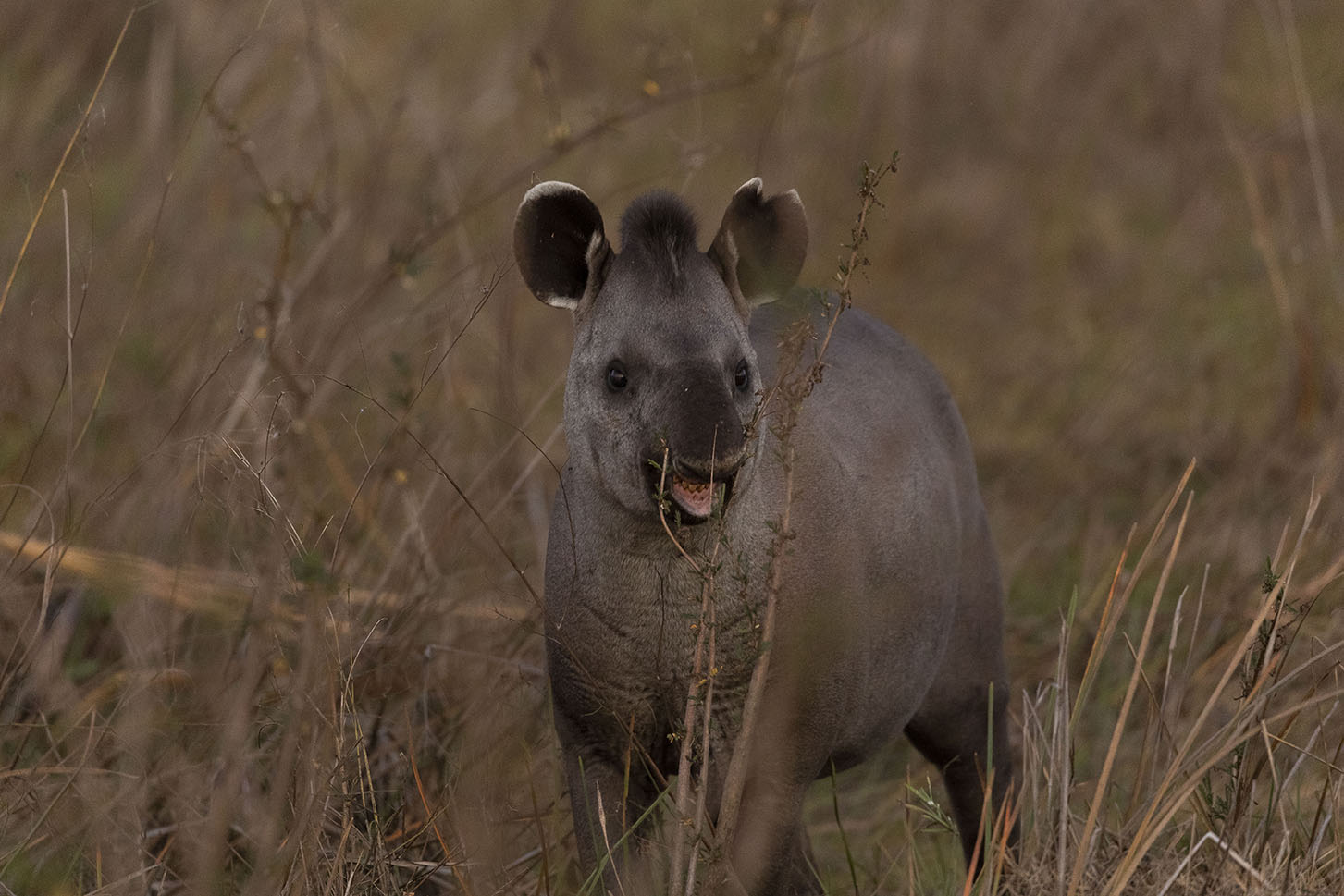 picture by: João Marcos Rosa
picture by: João Marcos Rosa
Since 1996, we have carried out work for the conservation of the Lowland Tapir (Tapirus terrestris). Work began work promptly in the Atlantic Forest of Pontal do Paranapanema (SP), and then advanced to other biomes, thus giving rise to the Lowland Tapir Conservation Initiative (LTCI). The main objective is to develop regional conservation strategies, based on science and plans to mitigate threats to the species in the biomes where it's still found (Atlantic Forest, Pantanal, Cerrado and Amazon).
LTCI is today the largest tapir study in the world. Long-term work gave rise to the most complete database on the species, which provides information to scientists from various countries and is widely used to influence the decision-making process for the animal's conservation policies.
The team captured 165 different tapirs, 35 in the Atlantic Forest, 95 in the Pantanal and 35 in the Cerrado, for reasons such as collar placement and removal and data collection on social hierarchy and reproduction. All in all, 101 tapirs were monitored for extended periods of time.

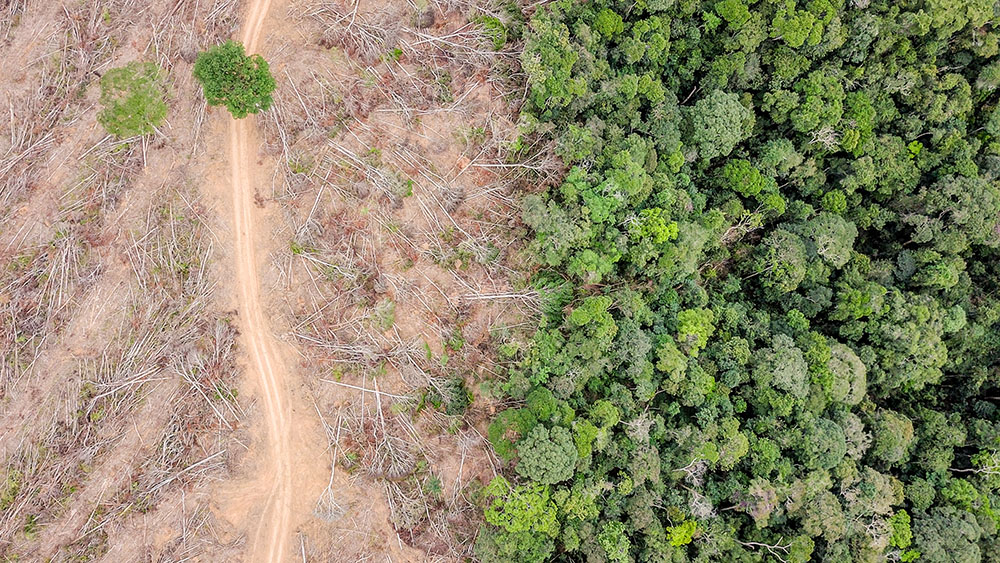 picture by: Laurie Hedges
picture by: Laurie Hedges
In 2019 another important step was taken as we started our tapir conservation work in the Amazon, thus bringing the conservation work for the tapir and its habitat to an end.
A 30-day expedition, carried out in June 2019, covered more than 5 thousand kilometers along the southern arc of deforestation, passing through Rondônia, Mato Grosso and Pará. In this region there's a variety of human activities which include large-scale agriculture (soybeans in particular), livestock, mining and palm oil plantations, amongst others. The aim was to check the status of tapir in the region and draw up a plan for research on the species in the region for 2020.
We rely on manifold crowdfunding donators from around the world to make these expeditions viable.

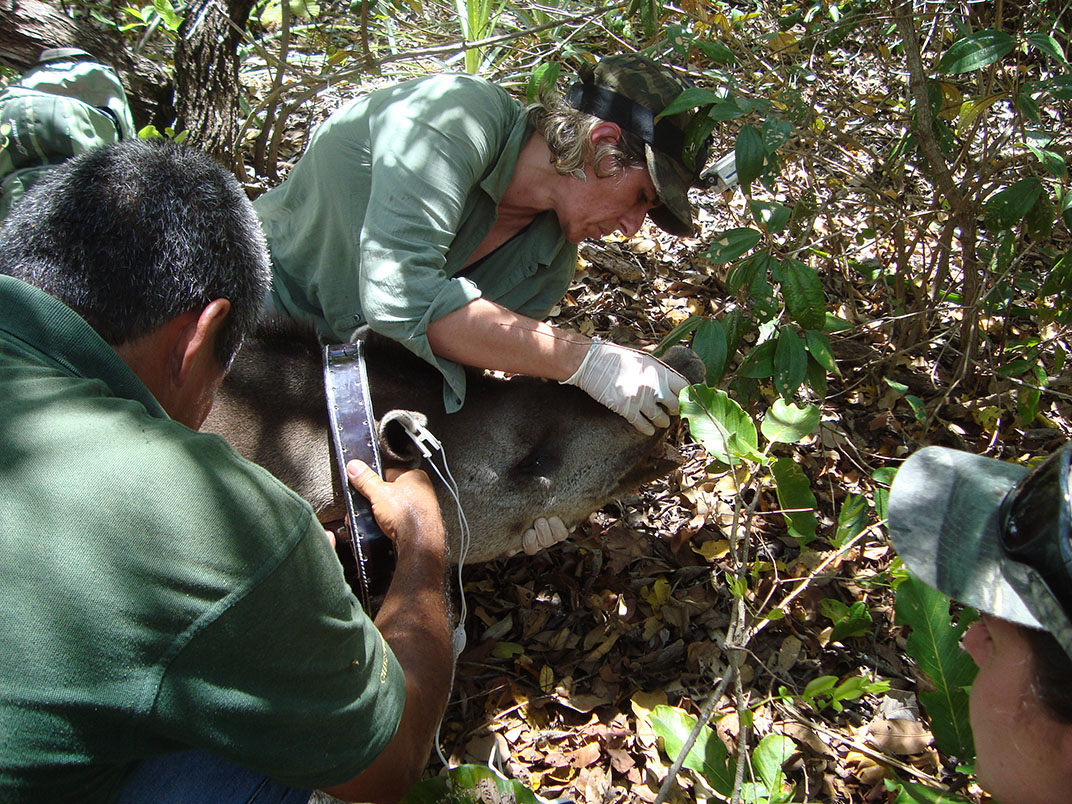 Arquivo INCAB/IPÊ
Arquivo INCAB/IPÊ
In the Pantanal, LTCI's research is carried out in the Fazenda Baía das Pedras, an environment better balanced ecologically-speaking than the Cerrado, where the threats to wildlife are higher due to pesticides and busy roads. The disparity between these two areas of study is significant as it allows for the comparison of animal behavior and health condition in such diverse environments. In 2019, we conducted two capture expeditions in the Pantanal (Fazenda Baía das Pedras). In all, 33 tapirs were captured (24 recaptures). The animals are tagged with GPS collars to monitor dispersion and social and family structure. That same year, scientists from the Grupo de Especialistas em Planejamento da Conservação from the Species Survival Commission (SSC) of Conservation Planning Expert Group of the International Union for Conservation of Nature (IUCN) linked to the Conservation Planning Specialist Group (CPSG) contributed through the LTCI team in modeling the Pantanal and Cerrado tapir populations. The methods of capture (box traps and tranquilizer darts) are used in all areas of study for research of spatial ecology, landscape movements and spatial overlap. Another method used is the camera trap, which is for analysing tapir social order and reproduction in the Pantanal. Currently, 50 of these traps are distributed around the Baia das Pedras. Since 2010, the camera trap study has resulted in 24 thousand photos and videos.
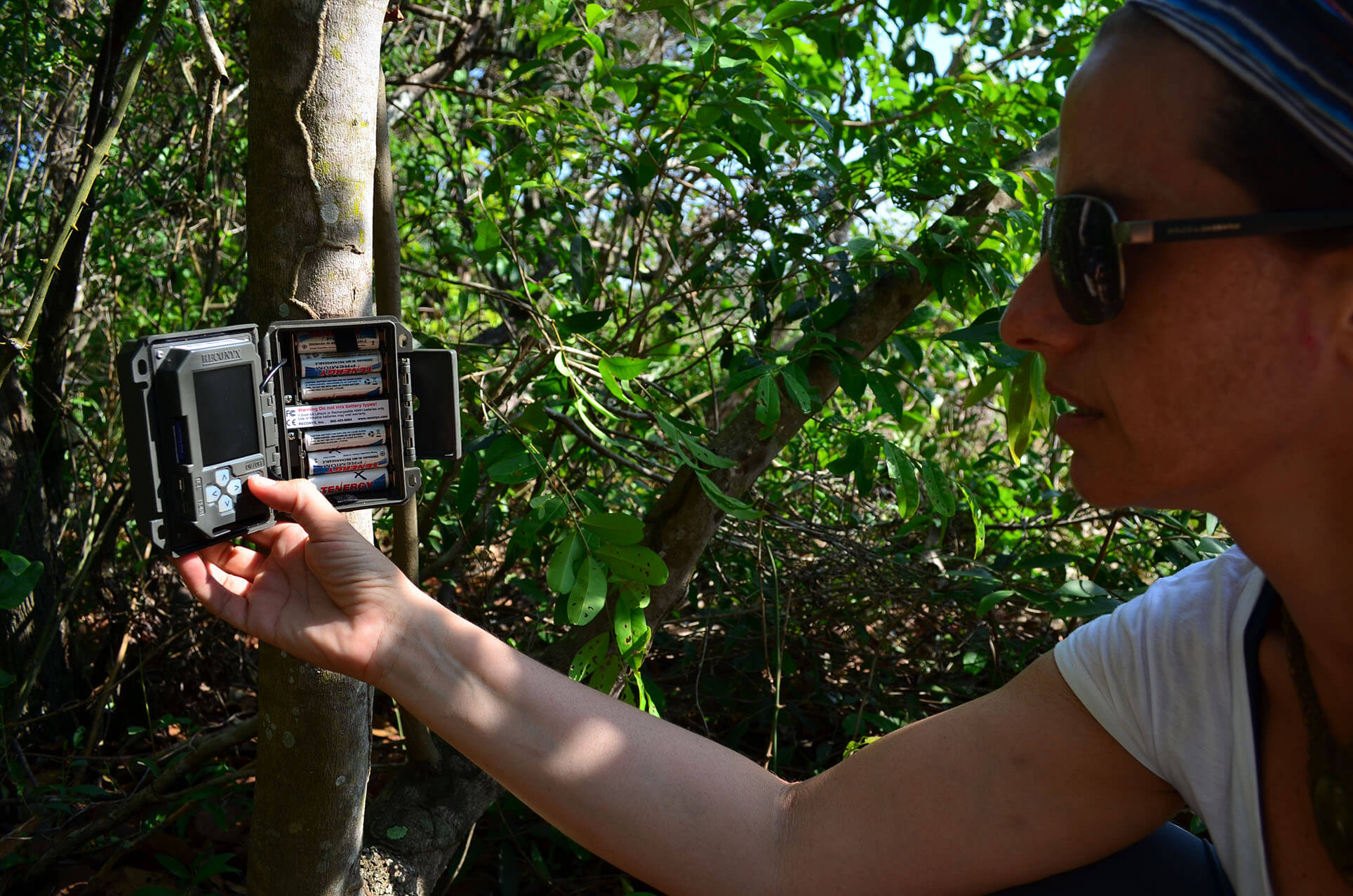 Arquivo INCAB/IPÊ
Arquivo INCAB/IPÊ
Monitoring the tapirs, either by satellite telemetry or camera trap, provides extremely important data. Over the years, we have been able to record hundreds of breeding events and learn about the interaction between females and calves. Several females we monitor had calves between 2015 and 2017, most of them survived, which provided us with an incredible opportunity to monitor their growth and development, their social interactions and parental relationship. In 2020, this data will be published in the population viability analysis (PVA).


In Brazil, there is a prejudice with tapirs. They are considered an animal without intelligence. So, saying somebody “is a tapir” is considered offensive. But, tapirs aren't lacking in the intelligence department! The animal boasts a high neuron count, it's agile and is key for biodiversity. We got "#antaéelogio" (meaning "tapir appreciation") going viral on social networks to get them some recognition. Share it too!
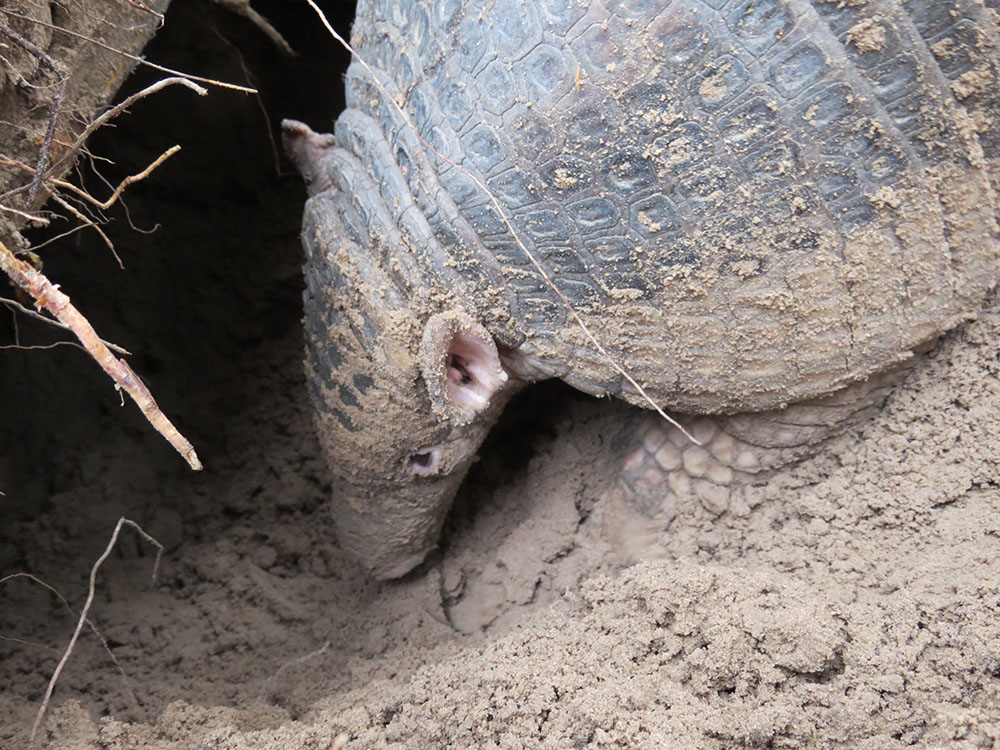 picture by: Projeto Tatu-Canastra
picture by: Projeto Tatu-Canastra
The Tatu-Canastra (giant armadillo) project, carried out by IPÊ and the Institute for the Conservation of Wild Animals (ICAS), began in 2010 in the Pantanal of Mato Grosso do Sul and expanded its work into areas of the Cerrado (Mato Grosso do Sul) and Atlantic Forest (Minas Gerais and Espírito Santo) over the years. The primary objectives of the project are to research the giant armadillo's (Priodontes maximus) evolution and biology, as well as using field data for planning and influencing public policies for its conservation.
The project was pioneering in its methodologies of investigating the ecology and biology of the giant armadillo and is one of first in training aspiring conservationists. The initiative has already documented the important role of armadillos as ecosystem engineers, and has consistent data on the spatial ecology of species and their habitat selection, as well as information on their health, diet, reproduction and communication.
Part of the data collected over the years was published in four scientific articles, in 2019. In 2020 there will be new articles published on the species. Information on the armadillos aids in the decision-making process of conservation and was even used in the construction of the Plano de Ação Nacional (National Action Plan) for the giant armadillo. Said plan was validated by the ministry for the environment as well as the Chico Mendes Institute for Biodiversity Conservation in July 2019. http://bit.ly/artigostatu2019

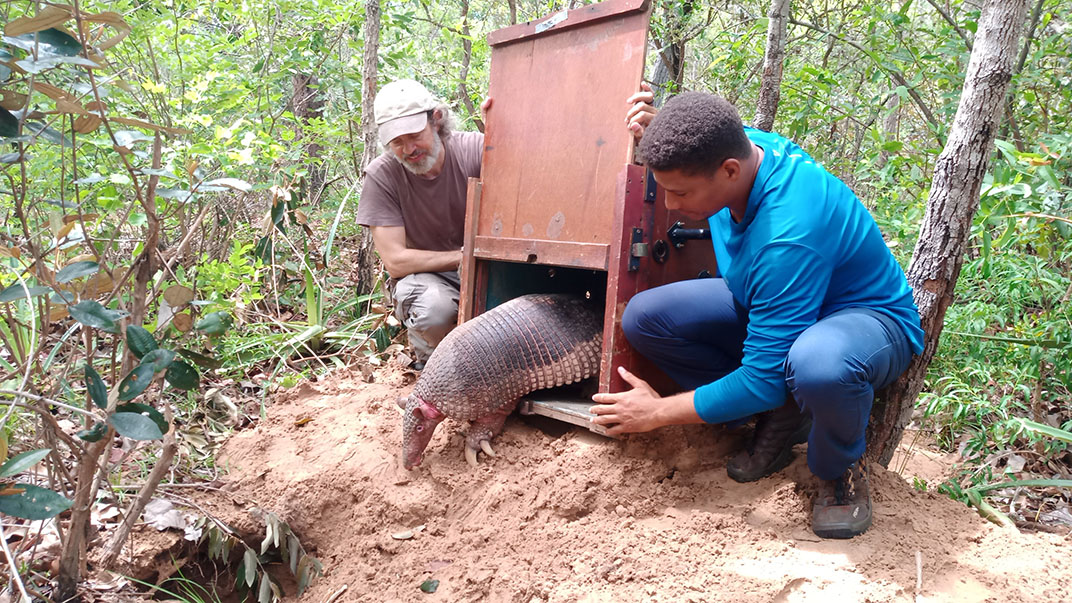 picture by: Projeto Tatu-Canastra
picture by: Projeto Tatu-Canastra
In a 360 square kilometer area around the farm Baía das Pedras (MS), the project carried out eight research expeditions in 2019. Four new armadillos were captured, among them a young female, which will help us fill in data on giant armadillos parental relationships. Such as at what point exactly mother/calf separation happens. During these expeditions we managed to implant 10 new GPS devices in recaptured armadillos. The reproduction and sexual maturity data for the species is all set and waiting to be published in an article in 2020.
Pantanal species studies are long-term and by 2020 will have been going on for 10 years. We're now also using a new piece of innovate technology: a new activity sensor inside the GPS device. A new permanent grid will also be set up throughout the study area, monitoring possible social interactions (animals visiting each other's living area), reproduction and armadillos health.
In 2019, the researchers conducted an expedition to Rio Doce State Park, The last park in the Atlantic Forest known to be home to the giant armadillo and has confirmed the species' presence there. In 2020, with support from the Whitley Fund for Nature, a new project will be underway in the region, to assess the viability of the species population and involve the local population so the animal becomes a source of pride and a symbol of conservation efforts in the park. The fieldwork is going to involve creating camera trap networks and visiting nearly 70 areas around the park.
Seven field campaigns were carried out in the BR-267, Mato Grosso do Sul area, from April to November 2019. The aim of which was to evaluate the armadillo population density and positioning in the area. While working in 32 rural areas there in which we chose 50 zones for study and installed 150 camera traps in various spots. We recorded 22 species of medium to large mammals in 20 of the 50 zones that were studied.
After the surveys were carried out in the Cerrado and the Atlantic Forest, the project put together maps of the area which illustrate armadillo positioning. They are now available to the government. Now the plan is to encourage the establishment of such protected areas for armadillos and other important species too.

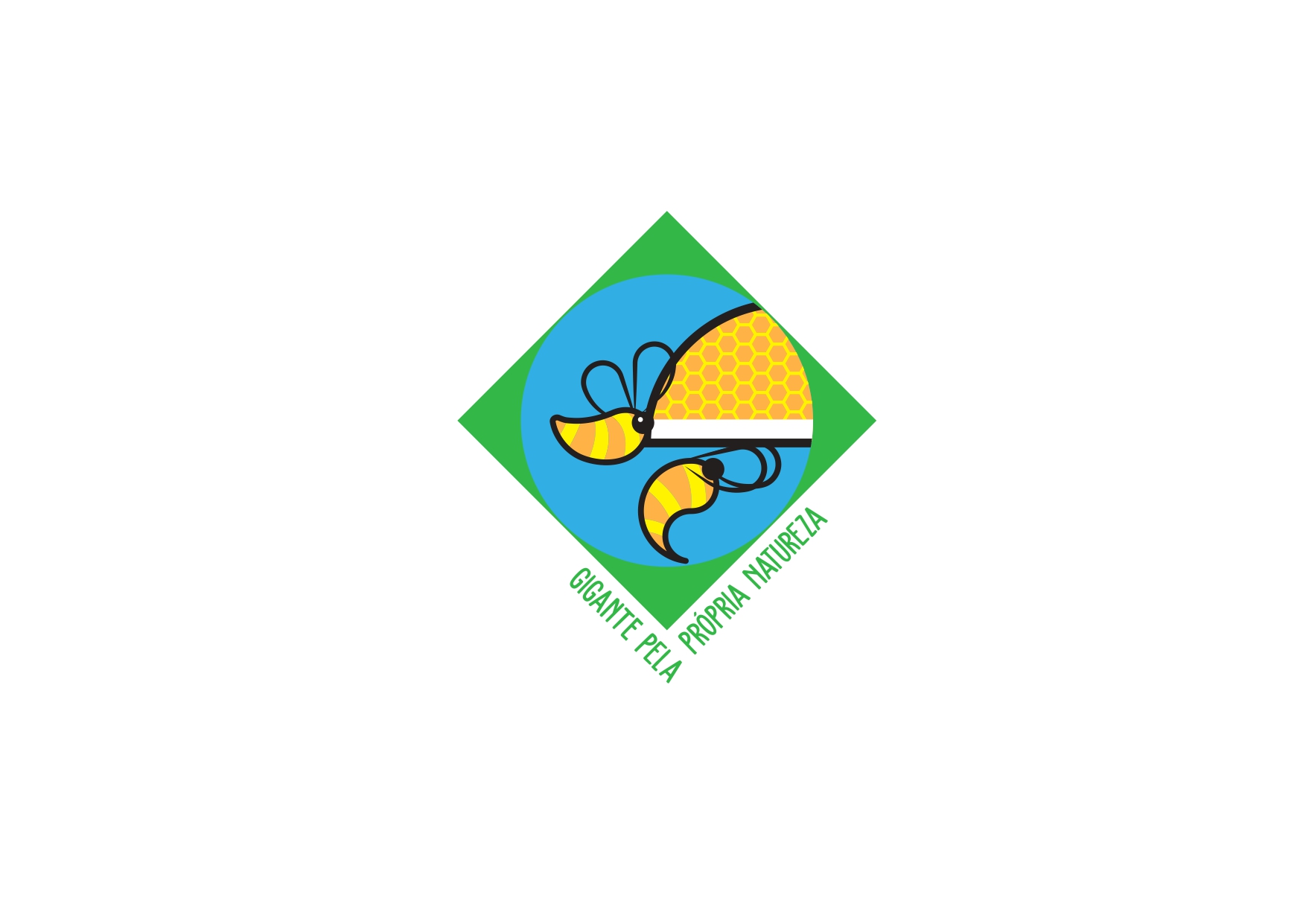
In Cerrado, Mato Grosso do Sul, a conflict is arising, endangering the lives of the giant armadillos and local beekeepers activity. As hives and beekeeping production are close to the last native forest areas of the biome, armadillos are drawn to it and destroy the hives to eat the bees and larvae. Beekeepers often put poison on the fallen hives, which leads to the death of armadillos and giant anteaters, amongst other animals too. Some research is already pointing out that due to the farmers action there is now localised extinction of the armadillo species.
In 2019, we installed camera traps in the production areas to gather evidence of the armadillo behaviour. We conducted interviews with 135 producers and, after lengthy conversation with some of the farmers, we created the wildlife-friendly beekeeper stamp, to raise awareness of the importance of keeping armadillos alive in nature. The stamp is a sign the farmer is caring for the native fauna and serves as a way for the farmer to diversify their target market for product sales.
In 2020, the certification criteria will be laid out, together with the Wildlife Friendly enterprise Network (WFEN). As for rural extension work, mitigation measures and certification for associations and eucalyptus plantations will be endorsed.


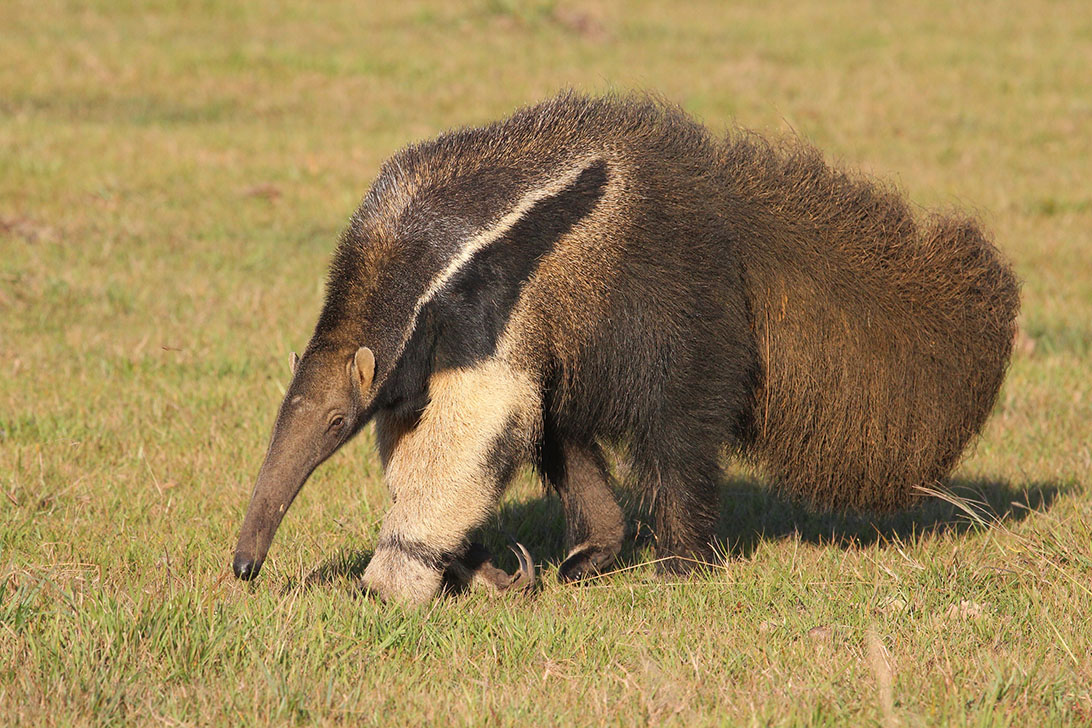 picture by: Jason Wollgard
picture by: Jason Wollgard
With the Bandeiras & Rodovias (Anteater & Highway) project, researchers from IPÊ and ICAS (Institute for the Conservation of Wild Animals) are looking to measure the impact that roads have on the giant anteater's (Myrmecophaga tridactyla) survival, population structure and health. The giant anteater and other animals are often run over on these roads. The project seeks to define landscape and road management strategies to prevent potential extinctions.
1,337 kilometers of highway has been monitored since 2017 every fortnight. In two years, 11,199 dead animals were recorded. Among them, 44 giant anteaters.
To better understand this issue, we interviewed lorry drivers passing through the BR-262 and BR-267 highways and analysed the data, which will contribute to more effective measures of raising awareness.
Data from photo traps dotted along the BR-267 is also being analysed, as well as samples of 1255 animals and 102 necropsies (of 62 anteaters) that will lead to more data about the health of these creatures.
The Anteater & Highway project recorded, in two years, , 11.199 animals killed on the roads in Mato Grosso do Sul, including 44 giant anteaters. These run-ins with traffic have halved the giant anteater population growth rate for those that live near the roads. We are still working with truck drivers to understand how we might prevent these accidents.

Under researcher Rafael Chiaravalloti's management, IPÊ started research related to fishing communities in western Pantanal; the region of Serra do Amolar. The proposal being to understand the so-called socio-ecological systems and how communities adapt to changes in the environment to survive. The study can be found at bit.ly/socio-pantanal.